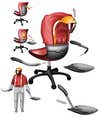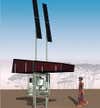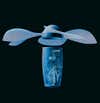CARE: A Project Inspired by WWW.CARE.ORG
The 2004 Popsci Design Competition
For the 2004 Popular Science invitational design competition, we chose the theme of “technological CARE packages for the 21st century.” What good, we asked, might emerging technology do for global communities in need? We put the problem before internationally renowned designers, architects and thinkers. The results surprised and delighted us. Whales, it seems, need noise-cancellation devices. Office chairs should morph, like Transformer toys, into survival gear. Bombed-out villages need utility centers powered by wood or the turn of a bicycle wheel. And cities need to gaze at newborn stars.
Meet the jury for the 2004 Popular Science invitational design competition.
When we decided to build a design competition around the idea of a 21st-century CARE package, the idea was to move well beyond the original 1945 template. Those simple boxes of Spam, lard, cornmeal, powdered milk and other American staples saved the lives of many starving Europeans after World War II. But soon after 1945, CARE was air-dropping tools, blankets and medicine as well. Over the decades the concept of international relief evolved to include transfer of expertise and technology and the encouragement of self-help in communities in need.
The parameters for those invited to participate in our competition were left wide open: We asked the entrants to identify a community, define a need (it could be “any urgent, definable need: social, political, cultural, domestic or international”) and then imagine a technological fix. The technology itself should be extant or within reasonable hailing
distance, and a matchmaking service was offered: We would pair entrants with experts in scientific or technological fields related to their concept.
When the folders, discs and e-mail attachments arrived at our offices early this spring, the projects revealed in roughly equal measures the influence of CARE, the nightly news, Florence Nightingale and the 101st Airborne Division. The judges encountered fleets of autonomous underwater vehicles to save sonar-assaulted whales; survivalist office chairs; deployable sweet-water systems; and a savagely satirical project called PAL of the USA, for People About to be Liberated by the United States of America, in which the community receives a “smart bomb” ordnance of iPods, hot dogs and other Americana. Some entries were dead serious, some a mere provocation and some a techno-poetic gloss on the predicament of western communities lost in their own machine-made fog.
Taken together, the CARE packages mirror their creators’ first-world sense of technological might: Membership has its privileges. Who else can afford to consider electroactive polymers, Technogel, woven-fabric electroluminescent displays and 3-D scanners as aid? Yes, attention was paid to basic needs–for purified water, for example–but it seems humanity also requires sleeker portable communications devices, more and better network access, more terminals and displays, and all the power sources to feed them, from solar to steam to hypothetically efficient Stirling engines.
The judges were experts on design, technology and the blurry line between fancy and feasibility. They met around a table at the magazine’s headquarters to evaluate the entries. Epithets shot back and forth, from “technoporn” to “fantasy projections” to “commercial home run.” There were plenty of practical questions: “Why do you need connectivity in the same box with water purification?” “Does it allow people to create an economy or is it going to be a burden?” “What happens when this technology breaks down?” What rumbled under the hood of the proceedings was not so much the problems of specific technologies, it was a more philosophical issue: In the real world, would these technologies, these silicon CARE packages, be real gifts or simply more levers of influence in the balance of power?
Tech to the Rescue
War, the collapse of infrastructure and the necessity of portable, rapidly deployable technologies were givens assumed by most of our Design Challenge entrants, and none more clearly than Alexander Rose and Danny Hillis in their Swiss Army Knife of a package, which took the grand prize. Its nickname: the “Care cube.”
“We were doing this post-9/11, and after the blackout that hit the eastern seaboard last August,” says Rose, who is executive director of San Francisco’s Long Now Foundation, which studies time and culture in up to 10,000-year chunks. “It struck us that loss of infrastructure is the basis of â€community in need,’ and this comes down to three things: clean water, communications and power.”
They wanted to squeeze solutions to these three huge needs into a box six feet square, weighing maybe a ton. During the three months they worked on the project, Rose went on sabbatical to Borneo, Laos, Cambodia, Vietnam, the Philippines and Thailand, along the way exchanging e-mails with Hillis, a computer scientist who has built two prototypes of 10,000-year clocks for the Long Now Foundation. The duo pictured a box stocked with solar-powered cellphone-PDAs that keep pinging other units until their users’ messages are picked up or make their way to the Internet. The box would feature configurable LCD screens and software-driven keyboards that could shift easily between the alphabets of different languages, along with retractable sinks and water-purification filters. A Stirling engine, fueled by solar reflectors or a combustion box, would store energy. If either of these power sources failed, a stationary bicycle could generate electricity and give the user an aerobic workout in the bargain.
“The surprise for me,” Rose recalls, “was how many communities where I was traveling could use this. No place had water, power and communication at the same time. But what was also interesting was how quickly new technologies were picked up. The key is serviceability. If you can’t maintain the technologies, they get junked as fast as they arrive.”The powerful impact of obsolescence was on the mind of another winner, Andrew Zago, whose firm’s Self-Contained Community Telecenter took an honorable mention. “Toxic colonialism” is the phrase that Zago uses to describe the problem of global techno-dumping. Three hundred and twenty-five million computers will become obsolete this year in the United States alone, according to the U.S. Environmental Protection Agency, and huge numbers of them will add to an Everest of e-junk that is strewn through China, India and Pakistan. One infamous site, the town of Giuyu, China, is a poster child for environmental disaster, with its dumping grounds, poisonous smoke and river choked by stripped and melted computer parts.
Zago, whose architecture firm is based in New York City and Detroit, imagined a second life for some of this discarded stuff. “Obsolete is a relative term,” he says. “There’s no end to the people who can use things that were called â€blazingly fast’ a few years ago that we’ve thrown away.” His reconstructed computers and satellite modems would, at least in a symbolic way, reduce the dumping while offering a way onto the grid for the technologically impoverished. The plan also addresses another problem. If a CARE package simply serves its need and is exhausted–the way a container of food is–then it’s a one-way transmission. It never gets at the more profound issue for broken communities: how to build or repair a self-sustaining social network. Zago’s package, along with Rose and Hillis’s, proposes a route into the network. Their charitable machines create skills and work, encouraging local microeconomies in an unstable world.
Forging Connections to the Cosmos
Broken communities, threats and instability are hardly confined to the third world. Terrorism on a planet criss-crossed by digital and transportation networks gives the concept of the global village a new, darker meaning. Ecco Design’s Soteria office chair, another honorable mention winner, suggests this in its compact, double-duty frame.
The Soteria’s designers, Eric Chan and Valerie Trauttmansdorff, say that what they imagine office workers sitting on is “more than a post-9/11 chair. It’s for any disaster, not just terrorism.” Sure. But the attack on the World Trade Center looms in the mind’s eye. Named after the Greek goddess of rescue, the Soteria is cleverly crammed with a fire-resistant helmet and jacket, a back that becomes a shovel, an arm that can break glass, and sensors that track location, your heartbeat, smoke and heat. “If something bad happens, what do you need?” Chan asks. “Three things: something to protect your skin, something to help you breathe, something to get debris out of your way.”
The importance of connectivity and the networks shaped many of the winning projects; in the Soteria, it’s expressed by the integrated i-Bean technology, made by Millennial Net, a Cambridge, Mass., and Tokyoâ€based developer of wireless sensor networks, which creates an office-wide monitoring system that maps every chair in the system.
The global village, the emerging ubiquitous network and the definition of community: These began to blur and take on different shapes as the judges made their way through the entries. What do “community” and “need” mean? There might, one entry suggested, be an urgent need for CARE packages that extends to other species. Community is a social pattern among creatures, it doesn’t matter which ones, and need is need.
Over a five-hour dinner at a Mexican restaurant in Seattle last fall, with not a small amount of tequila involved, Shawn Brixey and his students at the DX Arts Center for Digital Art and Experimental Media at the University of Washington began to think about whales. The expertise around the table ran from acoustics to marine science and robotics. Ian Ingram, Bret Battey and Brixey fell into talking about controversial high-intensity sonar signals–bursts of low-frequency sound that the Navy is experimenting with to seek out enemy subs. Studies are tracking the danger these signals pose to whales, which may be distracted, deafened, even killed by a sonar din that could drive them from the deep in a panic, causing potentially fatal gas-bubble lesions like the ones divers experience when they get the bends. Why not give whales the equivalent of Bose noise-canceling headphones? And so the concept of Active Noise Reduction Autonomous Underwater Vehicles was born.
“Power, wealth, technology, maneuverability, the military and impact on the environment are the essence of what CARE is about,” Brixey says, “and we thought an expansion of the concept–though we knew it was a little wild–would be to address other species.” Brixey’s team envisioned drone planes dispatching flocks of robotic subs (known as autonomous underwater vehicles, or AUVs). Turning in formation beside their charges, they pump out sound waves to counter the damaging low frequencies. The idea earned the Editors’ Choice Award for its visionary reach. But Brixey protests: “It’s not just visionary. If the Navy wanted to make the investment, they could do this in a decade. Drones were used in Afghanistan and Iraq. The Navy has tons of AUV research. We’re artists,” he says. “You have to dream a little. But we’re talking about functional machines. This really isn’t pie in the sky.”
Leave it to Julian LaVerdiere and Paul Myoda, whose whimsical Urban Lodestar entry took second prize, to tackle pie in the sky. The need LaVerdiere and Myoda identified was simple: For city dwellers peering upward, who see
a haze of urban illumination instead of the pinpricks of the stars, the yearning and awe that the night sky has so long inspired is lost.
“We wanted to fulfill unfulfillable needs,” LaVerdiere says. “I’ve always liked the aspirational elements of the optimistic and absurd in Jules Verne. Light has always had these associations with both science and mysticism, whether it be a candle or a laser, and we were trying to wed them with this notion of an artificial star–something rehabilitative to bring back wonder and raise our spirits.”
After reading back issues of Popular Science and talking to people at NASA, the artists conceived a pulsing, artificial star floating 20 miles up. It would consist of five high-altitude weather balloons linked in a ring, holding aloft a five-pointed star composed of electroluminescent piping and photovoltaic cells that draw juice from the Sun. Suspended from the rig on electrical cables are a xenon strobe, battery packs and navigational boosters.
LaVerdiere and Myoda, who met as classmates at Yale’s art school in the mid-1990s, are experts at raising spirits. They designed the Tribute in Light at Ground Zero, was illuminated precisely six months after September 11, 2001. Two enormous high-intensity beams, ghostly and majestic, rose up into the night, evoking the vanished buildings.
One judge dismissed the Lodestar project as “galactic TV”; another liked the idea of using technology to address a spiritual, or at least quasi-spiritual, need. What LaVerdiere and Myoda offer is a gratuitous act of technological beneficence. Nothing tangible enters the market economy. Nothing shouts infrastructure collapse or pollution or monstrous crimes. This is its winning charm–a twinkling, xenon-powered respite from technology through technology, as far from fear as disasters are from dreams.

by Ecco Design

by Zago Architecture

by Julian Laverdiere and Paul Myoda; Nasa; Rose Ether

by Jameson Simpson

sci0704intro_485x336.jpg

by Antenna Design

Expandable Medium is the Messa
Community: International aid workers
Project: Expandable, networked container

The Jury
Abrams is a design writer and the director of the Design Institute at the University of Minnesota. Cameron Sinclair
Architect Sinclair is the founder of the nonprofit organization Architecture for Humanity. Jeff Speck
Former city planner Speck is the director of design for the National Endowment for the Arts. Rodney Brooks
Brooks heads up the MIT Computer Science and AI Lab, and is chairman of iRobot Corporation. Chee Pearlman
Design Challenge director Pearlman heads Chee Company, a NYC-based design consultancy.

by Smith-Miller + Hawkinson

by Springtime-USA
Hot dog laced with nanotracking device
iPod loaded with âa’¬God Bless Americaâa’¬
Football (American)
Bazooka bubble gum